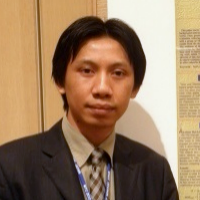International Journal of Information Technology and Computer Science (IJITCS)
IJITCS Vol. 4, No. 2, 8 Mar. 2012
Cover page and Table of Contents: PDF (size: 616KB)
Speech Quality Assessment of VoIP: G.711 VS G.722 Based on Interview Tests with Thai Users
Full Text (PDF, 616KB), PP.19-25
Views: 0 Downloads: 0
Author(s)
Index Terms
VoIP, speech quality assessment/evaluation/measurement, subjective methods/tests, G.711, G.722, Thai
Abstract
This paper presents the comparison between two codecs, G.711 and G.722 at 64 kbps, referring to speech quality perception using a subjective method called interview tests. These subjective tests have been conducted with 201 subjects, who are Thai native speakers that use Thai which is a tonal language, for accuracy and reliability of results. The results from testing with both codecs are almost the same; the scores are 4.17 for G.722 and 4.14 for G.711. After analyzing the results, it has been confirmed that G.722 does not provide better speech quality than G.711 to the Thai subjects significantly, which is consistent with previous information. However, these results could be used as the benchmark of G.711 and G.722 for speech quality assessment within Thai environments.
Cite This Paper
Therdpong Daengsi,Chai Wutiwiwatchai, Apiruck Preechayasomboon, Saowanit Sukparungsee, "Speech Quality Assessment of VoIP: G.711 VS G.722 Based on Interview Tests with Thai Users", International Journal of Information Technology and Computer Science(IJITCS), vol.4, no.2, pp.19-25, 2012. DOI:10.5815/ijitcs.2012.02.03
Reference
[1]ITU-T Recommendation P.830. Subjective performance assessment of telephone-band and wideband digital codecs. 1996.
[2]ITU-T Recommendation G.722. 7 kHz audio – coding within 64 kbps. 1988.
[3]ITU-T Recommendation G.711, “Pulse code modulation (PCM) of voice frequencies. 1988.
[4]C. Wutiwiwatchai and S. Furui. Thai speech processing technology: A review. Speech communication, 2007, 49 : 8-27.
[5]N. Thubthong. A study of various linguistic effects on tone recognition in Thai continuous speech. PhD. Dissertation, 2001, Chulalongkorn University, Thailand.
[6]A. E. Mahdi and D. Picovici. Advances in voice quality measurement in modern telecommunications. Digital Signal Processing, 2009, 19 : 79-103.
[7]H.W. Gierlich and F. Kettler. Advanced speech quality testing of modern telecommunication equipment: An overview. Signal Processing, 2006, 86 : 1327-1340.
[8]T. Uhl. Quality of Service in VoIP Communication. AEU-Int. J. Electron. C., 2004, 58 : 178-182.
[9]ITU-T Recommendation P.800. Methods for subjective determination of transmission quality. 1996.
[10]S. Uemura, N. Fukumoto, H. Yamada, and H. Nakamura,"QoS/QoE measurement system implemented on cellular phone for NGN," In: Proceedings of IEEE Consumer Communications and Networking Conference, 2008, Las Vegas, NV, USA : 117-121.
[11]ITU-T Recommendation P.800.1. Mean Opinion Score (MOS) terminology. 1996.
[12]S. Karapantazis and F.-N. Pavlidou. Voip: A comprehensive survey on a promising technology. Computer Networks, 2009, 53(12) : 2050-2090.
[13]T. Jaruvitayakovit. VoIP Status in Thailand. In: Proceedings of the 1st AUN/Seed-Net Electrical and Electronics Engineering Regional Conference, International Symposium on Multimedia and Communication Technology, 2009, Bangkok, Thailand : 128-130.
[14]V. Vanijja. VoIP Software Using Open Source. http://www.tridi.nbtc.go.th/library/upload/c6.pdf, 2009, (accessed: December 25, 2010)
[15]P. Chichareon, S. Kamolphiwong, S. Saewong and T. Kamolphiwong. Web based Configuration Manager for Asterisk Trunking System. In: Proceedings of the 8th PSU Engineering Conference, 2010, Songkla, Thailand : 198-203.
[16]P. Ratsamimonthon, S. Saewong, T. Angchuan,C. Jantaraprim and S. Kamolphiwong. Service Integration of Voice Communication and Web based Conference. In: Proceedings of the 8th PSU Engineering Conference, 2010, Songkla, Thailand : 204-208.
[17]P. Casaby and S. Puangpronpitag. Problem Evaluation of Security Issues in IP telephony Open Source software. In: Proceedings of the National Conference on Computer Information Technologies, 2010, Chanthaburi, Thailand : 33-38.
[18]S. Toomwan. A Study of Voice over IP. MS. Thesis, 2010, Mahanakorn University of Technology, Thailand.
[19]S. Jaksopha. VoIP Development for World Study Center Co.,Ltd.. MS. Thesis, 2010, Mahanakorn University of Technology, Thailand.
[20]A. J. Johansen. Improvement of SPIT prevention technique based on Turing test. MS. Thesis, 2010, Mahanakorn University of Technology, Thailand.
[21]S. Thewaphon. A Study of Voice over IP for Department of Agricultural Extension. MS. Thesis, 2010, Mahanakorn University of Technology, Thailand.
[22]M. Goudarzi. Evaluation of Voice Quality in 3G Mobile Networks. MS. Thesis, 2008, University of Plymouth, United Kingdom.
[23]T. A. Hall. Objective speech quality measures for Internet telephony. In: Proceedings of SPIE in Voice over IP VoIP Technology, 2001, Denver, CO, USA : 128-136.
[24]Telchemy. Voice Quality Measurement. http://www.telchemy.com/appnotes/TelchemyVoiceQualityMeasurement.pdf, 2008 (accessed:
December 10, 2011).
[25]Tektronix. VoIP Service Quality Measurements. http://www.tektronixcommunications.com/sites/tektronixcommunications.com/files/assets/ documents/2007.12.27.08.07.37_12403_EN.pdf, 2007, (accessed: December 10, 2011).
[26]Q. Xiao, L Chen and Y. Wang. An Efficient Dimension Reduction Quantization Scheme for Speech Vocal Parameters. International Journal of Information Technology and Computer Science, 2011, 1 : 18-25.
[27]J.-H. Chen and J. Thyssen, "The BroadVoice Speech Coding Algorithm," In: Proceedings of IEEE International Conference on Acoustics, Speech and Signal Processing, 2007, Honolulu, HI, USA : IV-537 - IV-540.
[28]Z. Cai, N. Kitawaki and T. Yamada, and S. Makino. Comparison of MOS Evaluation Characteristics for Chinese, Japanese, and English in IP Telephony. In: Proceedings of the 4th International Universal Communication Symposium, 2010, Beijing, China : 112-115.
[29]ITU-T. Qualification Quality Assessment Test Plan for the joint superwideband extension of G.722 and G.711.1. http://www.ietf.org/mail-archive/web/codec/current/pdfwM2asIvaFq.pdf,2008, (accessed: December 25, 2011).
[30]A. Takahashi, A. Kurashima, and H. Aoki. Quality Assessment of Wideband Speech Communication Services. NTT Technical Review, 2006, 4(4) : 47-51.
[31]M. Graubner, P.S. Mogre, R. Steinmetz, and T. Lorenzen. A New QoE Model and Evaluation Method for Broadcast Audio Contribution over IP. In: Proceedings of the 20th International Workshop on Network and Operating Systems Support for Digital Audio and Video, 2010, Amsterdam, Netherlands : 57-62.
[32]M. N. Ismail. Best VoIP Codecs Selection for VoIP Conversation over Wireless Carriers Network. Annals. Computer Science Series, 2011, 9 : 57-66.
[33]L. Miao et.al.. G.711.1 Annex D and G.722 Annex B. – New ITU-T Superwideband Codecs. In: Proceedings of IEEE International Conference on Acoustics, Speech and Signal Processing, 2011, Prague, Czech : 5232-5235.
[34]Psytechnics. VoIP client benchmarking report. http://www.ucstrategies.com/uploadedFiles/UC_Information/White_Papers/Microsoft/VoIP_benchmarking_report.pdf, 2007 (accessed: December 10, 2011).
